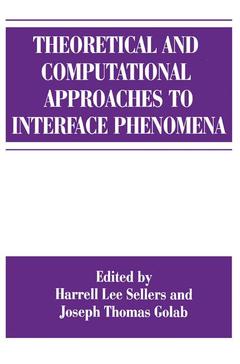Description
Theoretical and Computational Approaches to Interface Phenomena, Softcover reprint of the original 1st ed. 1994
Coordinators: Golab J.T., Sellers H.L.
Language: English
Subjects for Theoretical and Computational Approaches to Interface...:
Keywords
ITIES; Ion; adsorption; catalysis; electrolyte; metals; modeling; platinum; silver; structure; supercritical fluid
Publication date: 06-2013
246 p. · 15.5x23.5 cm · Paperback
246 p. · 15.5x23.5 cm · Paperback
Description
/li>Contents
/li>
Many chemical processes that are important to society take place at boundaries between phases. Understanding these processes is critical in order for them to be subject to human control. The building of theoretical or computational models of them puts them into a theoretical framework in terms of which the behavior of the system can be understood on a detailed level. Theoretical and computational models are often capable of giving descriptions of interfacial phenomena that are more detailed, on a molecular level, than can be obtained through experimental observation. Advances in computer hardware have also made possible the treatment of larger and chemically more interesting systems. The study of interfacial phenomena is a multi-disciplinary endeavor which requires collaboration and communication among researchers in different fields and across different types of institutions. Because there are many important problems in this field much effort is being expended to understand these processes by industrial laboratories as well as by groups at universities. Our conference titled "Theoretical and Computational Approaches to Interface Phenomena" held at South Dakota State University, August 2-4, 1993 brought together over thirty scientists from industry and academia and three countries in the western hemisphere to discuss the modeling of interfacial phenomena.
Reaction Path Approach to Dynamics at a GasSolid Interface: Quantum Tunneling Effects for an Adatom on a Nonrigid Metallic Surface (S.E. Wonchoba et al.). Catalysis Modeling Employing Ab Initio and Bond Order Conservation Morse Potential Methods (H. Sellers). Computer Simulations of Excitable Reaction-Diffusion Systems (M.R. Hoffmann, S.P. Müller). Molecular Dynamics Computer Simulations of Charged Metal Electrode Aqueous Electrolyte Interfaces (M.R. Philpott, J.N. Glosli). Molecular Dynamics Computer Simulations of Aqueous Solution/Platinum Interface (M.L. Berkowitz, L. Perera). Diffusion Mechanisms of Flexible Molecules on Metallic Surfaces (M. Silverberg). Computer Simulation of Solvation in Supercritical Fluids (G.S. Anderson et al.). Structure-Function Modeling in Blood Coagulation: Interfaces, Biology, and Chemistry (M.N. Liebman). Domains and Superlattices in Selfassembled Monolayers of Longchain Molecules (J. Hautman, M.L. Klein). Manipulation Wetting and Ordering at Interfaces by Adsorption of Impurities (D.J. Olbris, Y. Shnidman). Density Functional Description of Metal-Metal and Metal-Ligand Bonds (D.R. Salahub et al.). Index.
© 2024 LAVOISIER S.A.S.




